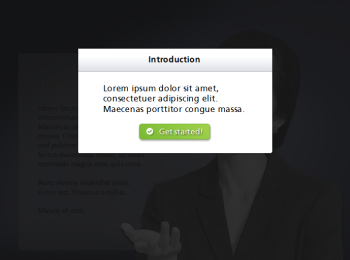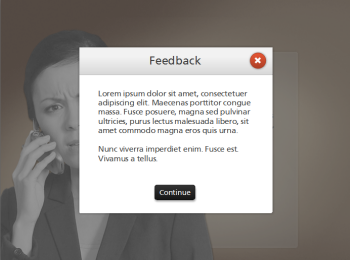Sometimes It’s Good to Stop Your Learners Before They Get Started |  |
| Sometimes It’s Good to Stop Your Learners Before They Get Started Posted: 12 Mar 2013 01:58 AM PDT
In my elearning workshops we discuss the parts of elearning courses that are common to most courses. One of the goals is to get participants to think through the common parts of a course and then determine how much of that can be prebuilt to save time. For example, most likely the course will have welcome and exit screens. They may not look the same for each course, but odds are that both will exist. Why not build a template that has a screen reserved for the welcome and exit process of the course? At this point, you're not assigning a look or feel; you're just making a space for it. Introducing the Gate ScreenAnother common part of many courses is what I like to call the "gate screen." It's a screen that serves as a gate by stopping the flow of information until the learner is ready to move on. Generally, there are two types of gate screens: introduction and feedback. Introduction Gate. This gate usually appears prior to the start of an interaction. It pauses the course to provide some introductory information and instructions. Then when the person is ready, she can advance.
Feedback Gate. The feedback gate does the same thing as the introduction gate—it pauses the flow and provides some information which is usually the result of a decision the learner's made. This type of gate is very common as feedback in elearning quizzes. Make a choice and hit submit. Up pops the feedback screen. Read the feedback and then click the next button (or possibly go back to make a different choice).
Both of these gates are essentially the same because they stop the flow of information, let the person regroup or get oriented, and then move on. As I stated earlier, these are fairly common in the construction of elearning courses. And since that's the case, why not plan for them in your design before you get started?
The two gate screens are essentially the same. They're gates that stop what you're doing; get you to focus on something; and when you're ready let you advance (or go back). And odds are that they'll be in your next elearning course. So why not save some time by putting them in the production queue before you get started? Do you use gate screens in your elearning course? If so, share with us how you use them. Tidbits
Work with me and the Articulate community! There's a cool opportunity to be part of what we're doing in the Articulate community. You can learn more about the job here. What you'll need:
We won't start to look at the applications until after the Learning Solutions conference so that should give you plenty of time to put together samples of your best work. *Also, check out all of the other open positions at Articulate. Upcoming workshops for 2013:
Download your free 46-page ebook: The Insider's Guide to Becoming a Rapid E-Learning Pro |
| You are subscribed to email updates from The Rapid eLearning Blog To stop receiving these emails, you may unsubscribe now. | Email delivery powered by Google |
| Google Inc., 20 West Kinzie, Chicago IL USA 60610 | |
--
Posted By tremeex to tremeex at 3/12/2013 09:11:00 AM
--
Posted By tremeex to tremeex at 3/12/2013 09:11:00 AM
--
Posted By tremeex to tremeex at 3/12/2013 09:11:00 AM
--
Posted By tremeex to tremeex at 3/12/2013 09:11:00 AM
--
Posted By tremeex to tremeex at 3/12/2013 09:11:00 AM
--
Posted By tremeex to tremeex at 3/12/2013 09:11:00 AM
--
Posted By tremeex to tremeex at 3/12/2013 09:11:00 AM
--
Posted By tremeex to tremeex at 3/12/2013 09:11:00 AM
--
Posted By tremeex to tremeex at 3/12/2013 09:11:00 AM
--
Posted By tremeex to tremeex at 3/12/2013 09:11:00 AM
--
Posted By tremeex to tremeex at 3/12/2013 09:12:00 AM





No comments:
Post a Comment